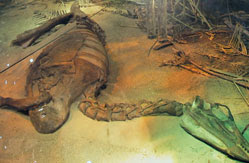Like from my previous post, this some more of my own photography from my private collection that I would like to share. Please enjoy them and leave a comment to say if you like them...
Welcome to "Natural Science"! This blog is dedicated to bringing you amazing facts about the natural world around you, and as a place to display my fossil, insect, rock/mineral, and other collections. I hope you enjoy the posts and pictures; feel free to leave a comment to tell me! Thank you
Thursday, May 17, 2012
Feather-saurus Rex
Look out for that feathery...Dinosaur? Yutyrannus huali was a relative of the mighty Tyrannosaurus rex. Found in northeast China, Yutyrannus specimen have been found with evidence that they were covered ,or partially covered, with short 15 centimeter feathers. Most of the feathered dinosaurs that have been found so far were small and are thought to have used their feathers for insulation. This doesn't appear to be the case with Yutyrannus because they would have lived in warmer climates,so it is thought that they used their feathers for courtship. It is hard to tell what they would have looked like exactly because few soft tissues are preserved and few complete specimens have been found. It most likely looked like a smaller Tyrannosaurus rex with a thin coat of feathers; it also had a bony nose plate. Who knows how future discoveries will help to reshape our view of dinosaurs.
Wednesday, May 16, 2012
The Tasmanian Tiger
 The Tasmanian Tiger, actually named Thylacinus cynocephalus, was a large carnivorous marsupial that became extinct around the the 1930's. Thylacine lived in Australia, New Guinea, and Tasmania and were related to species that dated as far back as the Miocene. Their length ranged from 39-51 inches long and weighed around 40-70 lbs. They resembled a large dog with short hair that had stripes near the tail. They are thought to have become extinct due to a combination of disease, habitat encroachment, and over hunting from farmers . Even though they are declared extinct there are occasional sightings ,but none of them can be proven to be real sightings. Thylacine are a true example of how we must work to preserve our remaining species.
The Tasmanian Tiger, actually named Thylacinus cynocephalus, was a large carnivorous marsupial that became extinct around the the 1930's. Thylacine lived in Australia, New Guinea, and Tasmania and were related to species that dated as far back as the Miocene. Their length ranged from 39-51 inches long and weighed around 40-70 lbs. They resembled a large dog with short hair that had stripes near the tail. They are thought to have become extinct due to a combination of disease, habitat encroachment, and over hunting from farmers . Even though they are declared extinct there are occasional sightings ,but none of them can be proven to be real sightings. Thylacine are a true example of how we must work to preserve our remaining species.Here is a video showing a possible Thylacine spotting and video of them in captivity...
(uploaded by bry3500)
Monday, May 14, 2012
Poisonous Birds
The world is full of poisonous snakes, poisonous frogs, poisonous fish, and poisonous BIRDS?! That's right, a poisonous bird. There are actually a handful of poisonous birds in the world. The first one that was discovered was the hooded pitohui which has two close relatives (Variable Pitohui & Brown Pitohui). These birds are songbirds that live on the island of New Guinea. These birds contain dangerous neurotoxin alkaloids and another poison similar to that of poison dart frogs. It is thought that the birds developed the toxin, which is stored in the birds feathers and skin, to ward off parasites and larger predators. These birds are just another example of the great biodiversity of Earth.
 |
| Hooded Pitohui |
Sunday, May 13, 2012
Dinosaur with a Heart
Fossils, just fossilized bones right? Wrong, sometimes soft tissues are preserved too. These samples help paleontologists to better understand the physiology of dinosaurs. One of the most notable soft tissue discoveries was "Willow". Willow was a herbivore from the late Cretaceous known as a Thescelosaurus (the actual species type is unknown). Willow was significant to science because it was the first dinosaur discovered with an internal organ, a heart. After determining that the heart was present due to a high concentration of iron, CT scans of Willow's heart found that it had a "single systemic aorta" which are normally found in warm blooded mammals and birds. This suggests that Willow was possibly warm blooded which would be an amazing discovery in dinosaur evolution. Currently, Willow is exhibited at the North Carolina Museum of Natural Science in Raleigh, NC. To read more about Willow visit... http://sites.naturalsciences.org/dinoheart/fastfacts/index.html
...or if you would like to see Willow in person you can visit the North Carolina Museum of Natural Science (http://naturalsciences.org/)
BBC also made a video shortly after Willow was found in April 21, 2000...
...or if you would like to see Willow in person you can visit the North Carolina Museum of Natural Science (http://naturalsciences.org/)
BBC also made a video shortly after Willow was found in April 21, 2000...
(video uploaded by BBCWorldwide)
Saturday, May 12, 2012
Killer Coelacanth
Found in British Columbia, Rebellatrix is an ancient fish related to the coelacanth; this fish has revolutionized the view of modern coelacanth. It has a fork-like stiff tail, similar to tunas; this suggests that it was a predatory fish capable of high speeds. Rebellatrix exhibits a very different view of coelacanth which leaves to question what other secrets are yet to be discovered. To read more visit...
http://www.sciencedaily.com/releases/2012/05/120502162441.htm
Photography
Like I said in my profile, I enjoy taking photographs. These are just a few of my favorite photos that I thought I would share. I hope you enjoy them; if you do like them please tell me by leaving a comment.
Subscribe to:
Comments (Atom)






















